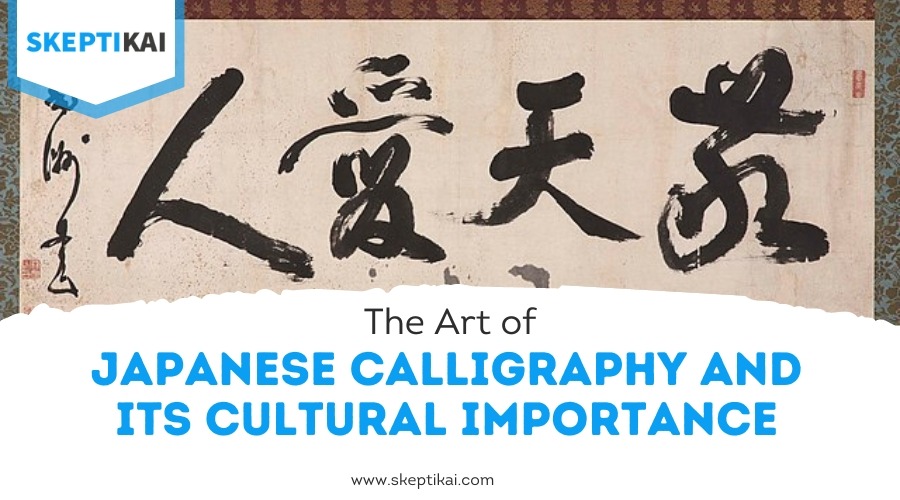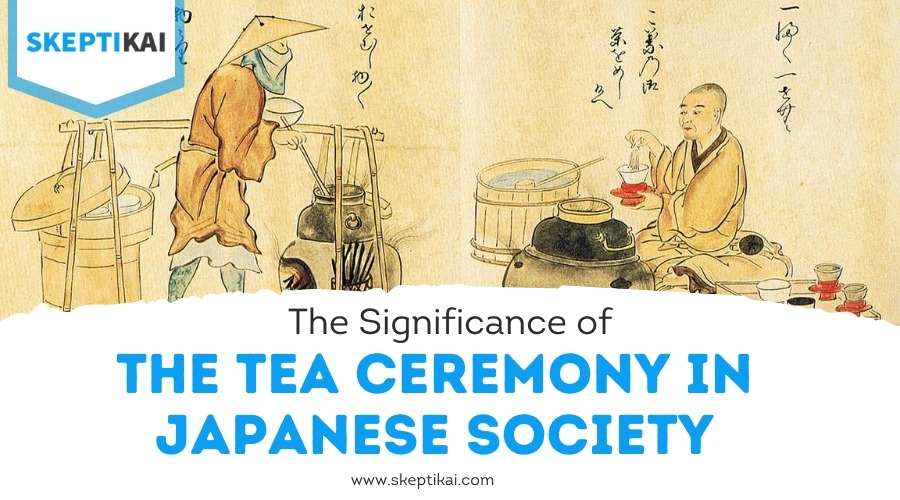Why Is Sushi Important to Japanese Culture?

You'll uncover that sushi plays an essential role in Japanese culture, symbolizing both tradition and groundbreaking artistry. Originating from ancient preservation methods, it has evolved into a culinary art form, harmonizing simplicity and elegance. Sushi's craftsmanship reflects Japanese aesthetics through balance and precision, using fresh, seasonal ingredients to honor nature. This meal fosters social bonds and welcomes regional diversity, with each variation offering insights into Japan's cultural landscape. Its influence extends worldwide, blending traditional techniques with cutting-edge flavors. Sushi is more than food—it's a celebration of Japanese heritage and philosophy. Investigate further to understand its multifaceted significance.
Historical Origins of Sushi
Originating as a method of preserving fish in Southeast Asia, sushi has evolved considerably over the centuries. You might be surprised to learn that the initial form of sushi, known as narezushi, was more about preservation than taste. Fish were packed in fermented rice, a practice that prevented spoilage and allowed them to be stored for extended periods. This technique was efficient for preserving fish in a time when refrigeration was non-existent. As sushi traveled from China to Japan, it transformed into a sophisticated dish, evolving from street food to a culinary art form celebrated for its unique taste, texture, and presentation. As you explore the narezushi evolution, you'll notice a significant shift from preservation to a culinary art. It was during the Muromachi period in Japan that the process began to change. The Japanese started consuming both the fish and the rice together, shortening the fermentation process. This marked a crucial moment in sushi preservation, as it transformed from a necessity into a more palatable dish.
Symbol of Japanese Aesthetics
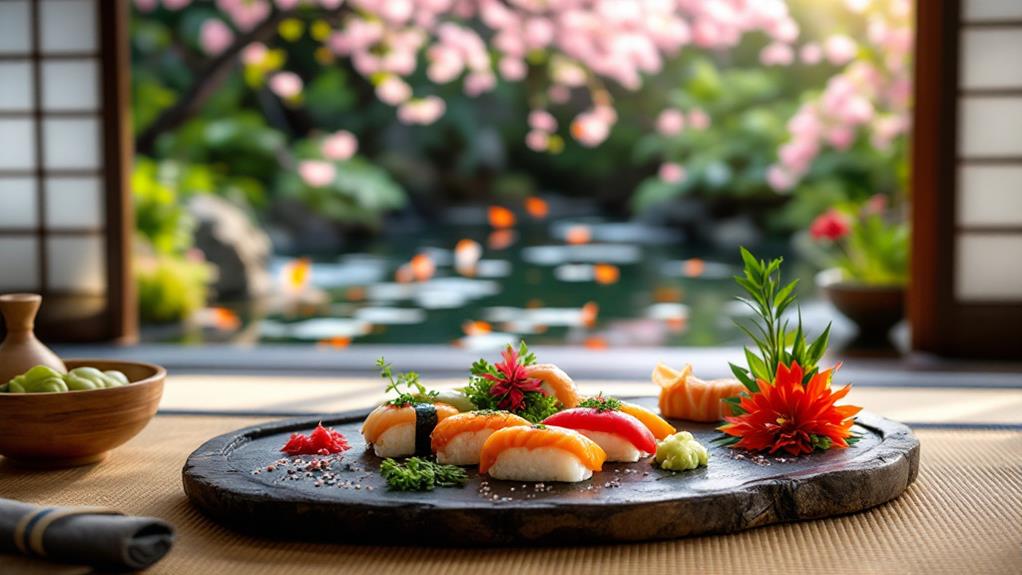
Sushi stands out as a quintessential symbol of Japanese aesthetics, blending simplicity with elegance. When you look at a plate of sushi, you're not just seeing food; you're experiencing an art form. The visual presentation is carefully crafted, where every piece is a harmonious balance of color, shape, and texture. This attention to detail reflects the Japanese value of beauty in simplicity. Likewise, the geisha tradition embodies the preservation of traditional arts and culture, serving as a symbol of Japan's enduring cultural legacy. In creating sushi, chefs use seasonal ingredients to guarantee freshness and flavor, which also brings a unique aesthetic quality. By using what's in season, they highlight nature's current offerings, showcasing the beauty of each component at its peak. This not only improves taste but also creates a visual feast that changes throughout the year. As you enjoy sushi, you'll notice the careful placement of each piece, demonstrating a deep respect for the ingredients and their sources. The artistry involved is a deliberate practice, embodying wabi-sabi — the appreciation of imperfection and transience. Through sushi's design and composition, you gain insight into Japanese aesthetics, which is about finding beauty in simplicity and celebrating the ephemeral nature of life.
Connection to Nature

As you appreciate the aesthetics of sushi, you also witness its deep connection to nature. Sushi isn't just about flavor; it embodies a respect for the environment. By using sustainable practices, sushi chefs honor the natural world, ensuring fish and seafood are sourced responsibly. They focus on maintaining the balance of marine ecosystems, which is essential for the long-term health of our oceans. This commitment to sustainability highlights the cultural value placed on harmony with nature.
Sushi also emphasizes the importance of seasonal ingredients, mirroring the natural cycles. Chefs select fish and other components based on their peak seasons, which not only improves the taste but also reflects the Japanese concept of "shun." This concept celebrates the fleeting beauty of nature, encouraging you to savor ingredients at their freshest. By doing so, sushi connects you to the rhythm of the natural world, fostering an appreciation for its ever-changing landscape.
When you enjoy sushi, you're not just indulging in a meal; you're participating in a tradition that respects and celebrates nature's bounty. Through sustainable practices and seasonal ingredients, sushi serves as a delicious reminder of our connection to the earth.
Culinary Art and Craftsmanship

Artistry lies at the core of sushi, transforming simple ingredients into an intricate culinary art form. When you explore the world of sushi, you quickly realize it's not just about rice and fish; it's about mastering sushi techniques and perfecting ingredient selection. The true creativity of sushi is in the details—how a chef slices the fish, the temperature of the rice, and even the way it's presented. Each element is carefully considered, reflecting years of dedication and refining one's skills.
To truly appreciate sushi, you must understand the significance of ingredient selection. Chefs prioritize the freshest, highest-quality ingredients, knowing that each component contributes to the complete experience. They take into account seasonal availability and regional specialties, ensuring that what arrives on your plate is nothing short of exceptional.
Sushi techniques are another vital aspect of its craftsmanship. You'll notice how chefs use specific knife skills to improve the texture and flavor of the fish. They also pay attention to the balance of flavors, ensuring that each piece of sushi is a harmonious blend of taste and texture. This detailed attention to nuance raises sushi into a revered culinary art form.
Regional Variations and Diversity
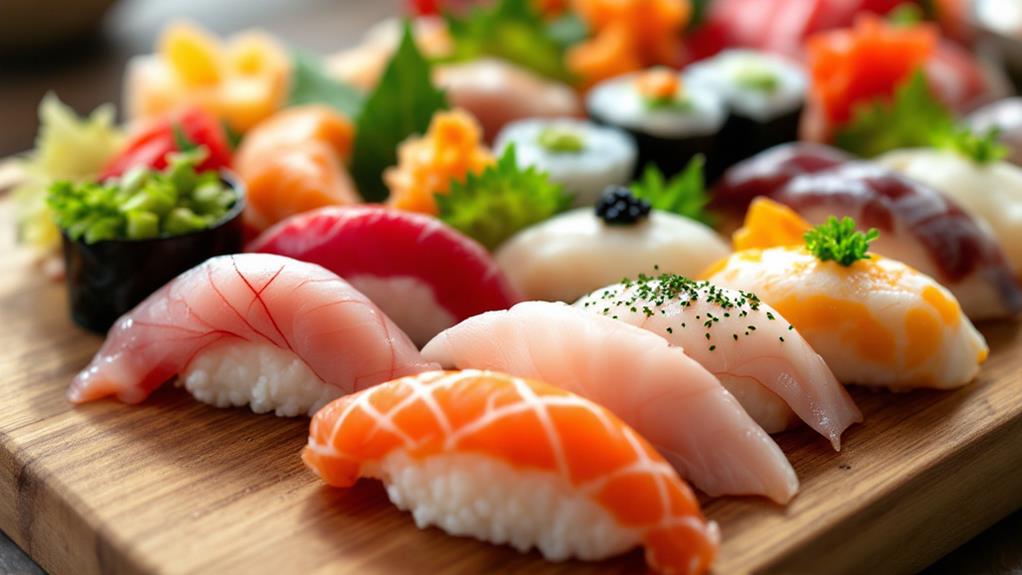
While the artistry of sushi is universal, its expression varies remarkably across different regions of Japan. You'll find a rich tapestry woven from regional ingredients, local techniques, and cultural influences that makes each area's sushi unique. Imagine savoring sushi made with freshly caught fish from the Hokkaido coast, or tasting the delicate sweetness of Kyoto's traditional sushi, which often incorporates subtly seasoned rice and local vegetables.
- Flavor profiles: Vary drastically, from the bold, vinegar-forward taste of Tokyo's Edomae sushi to the mild, freshwater flavors of Osaka's battera sushi.
- Seasonal variations: Highlight the freshest ingredients available, like the spring cherry blossoms influencing sushi presentation styles in certain regions.
- Community traditions: Often dictate the use of historical recipes, preserving ancient methods that have been passed down through generations.
These regional variations are more than just culinary; they're a reflection of Japan's diverse cultural landscape. Each bite offers insight into the community traditions and historical recipes that have shaped these culinary masterpieces. So, when you investigate Japan's sushi, you're not just tasting food—you're experiencing a mosaic of regional diversity and history that defines Japanese culture.
Social and Cultural Significance
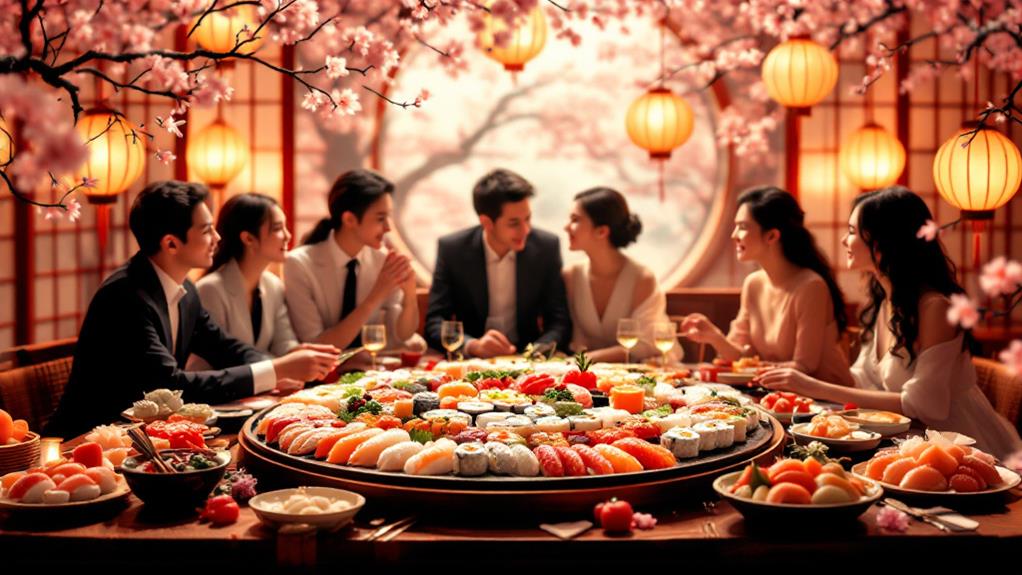
Sushi is more than just a meal; it's a cultural emblem that encapsulates Japan's social fabric and communal identity. When you partake in sushi rituals, you're engaging in a tradition that spans centuries. These rituals, from the precise preparation by skilled chefs to the thoughtful etiquette of eating, are steeped in history and honor. Engaging in these customs connects you not just to the food, but to Japan's rich heritage.
Communal dining, especially with sushi, emphasizes the importance of togetherness. In Japan, sharing a sushi meal is a social event where bonds are strengthened. Whether you're in a lively sushi bar or a quiet family dinner, sushi brings people together. It's not uncommon for conversations to flow as freely as the tea, bridging gaps between generations and fostering a sense of community.
Sushi transcends its ingredients, becoming a medium for social interaction. Each piece you share with others strengthens relationships, creating memories anchored in a shared experience. When you enjoy sushi, you're not just eating; you're participating in a cultural practice that unites people, honoring both the past and the present of Japanese society.
Representation of Harmony and Balance
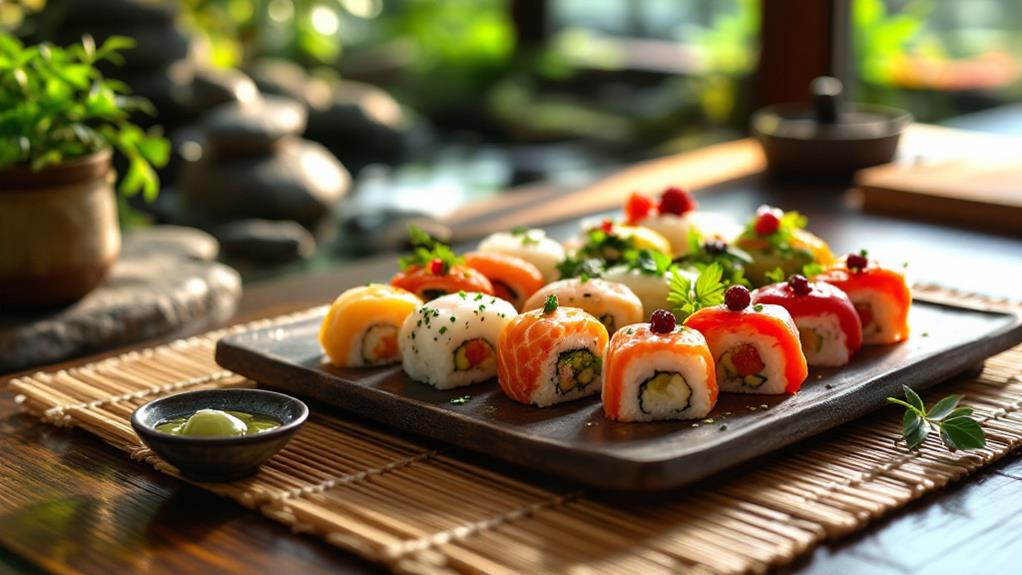
At the heart of sushi lies a profound representation of harmony and balance, which is deeply rooted in Japanese philosophy. Sushi is not just about the taste; it's a cultural symbolism of bringing together diverse elements to create a cohesive whole. This concept reflects the Japanese ideals of achieving equilibrium in both life and cuisine.
When you sit down to enjoy sushi, you're experiencing:
- Flavor balance: The combination of vinegared rice, fresh fish, and seasonings creates a perfect harmony of flavors that neither overwhelms nor underwhelms.
- Visual appeal: The careful presentation of sushi is an art form, illustrating the importance of aesthetics and attention to detail in Japanese culture.
- Seasonal ingredients: Using fresh, seasonal ingredients highlights the natural balance and respect for nature, another cornerstone of Japanese philosophy.
As you savor each piece, you're participating in a tradition that transcends mere eating. Sushi represents more than a meal; it's a meditation on the harmony between land and sea, simplicity and complexity. The balance of flavors and the cultural symbolism embedded in each bite serve as a reflection of the Japanese dedication to harmony, making sushi a fundamental part of their cultural identity.
Influence on Global Cuisine
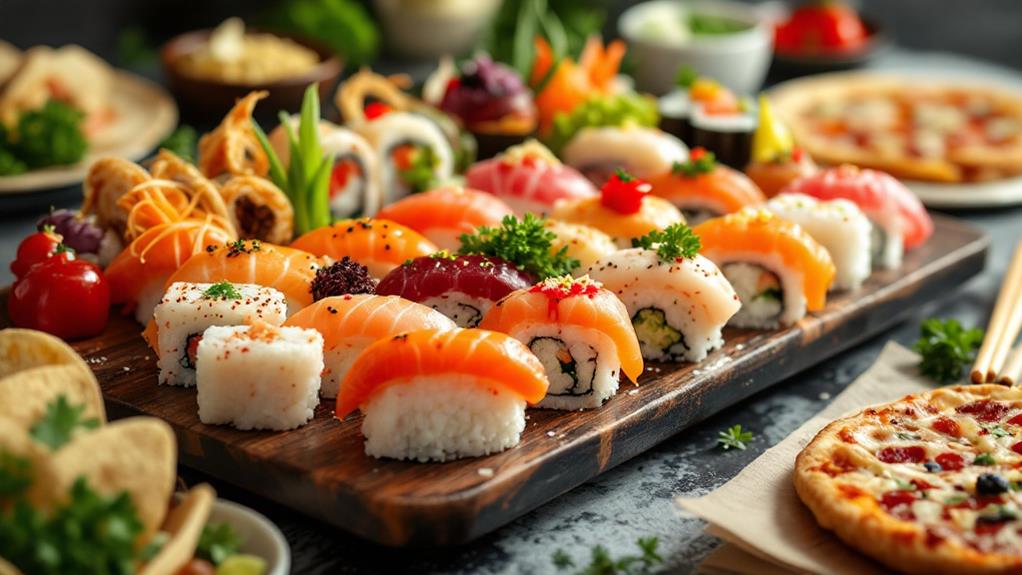
How has sushi managed to captivate taste buds all around the globe and influence international cuisine? It's all about its adaptability and the creative spirit it inspires. Sushi trends have spread like wildfire, leading chefs to experiment and push boundaries. You've probably seen sushi reinvented in imaginative ways in restaurants worldwide. From sushi burritos to sushi burgers, the fusion of sushi with other culinary traditions has opened up endless possibilities.
Culinary fusion is at the heart of sushi's global influence. By combining traditional Japanese techniques with local ingredients and flavors, chefs create dishes that appeal to diverse palates. You can find sushi with a spicy twist in Mexico or infused with Mediterranean flavors in Europe. This fusion not only celebrates sushi's versatility but also improves its accessibility, allowing it to resonate with different cultures.
As you investigate these exciting sushi trends, you're witnessing a harmonious blend of creativity and tradition. The global popularity of sushi encourages culinary ingenuity, inviting you to enjoy a dish that reflects both its Japanese roots and the lively cultures it encounters. Sushi's evolution across the globe showcases its power to unite people through shared culinary experiences.
Preservation of Tradition and Innovation

In the world of sushi, balancing preservation of tradition with innovation is key to its enduring appeal. As you investigate sushi's rich history, you'll notice it's not just about raw fish and rice. It's a dance between maintaining ancient techniques and embracing new trends that keep things fresh and exciting. Sushi chefs honor tradition by adhering to sustainable practices, ensuring the ingredients they use are sourced responsibly. This commitment helps preserve marine life and support local communities.
- Respect for tradition: Master chefs spend years perfecting skills passed down through generations, ensuring each piece of sushi reflects the essence of Japanese culture.
- Embracing innovation: Fusion flavors are introduced to attract new audiences, blending diverse ingredients and culinary techniques from around the world.
- Sustainable practices: Prioritizing eco-friendly sourcing guarantees that sushi remains a viable option for future generations.
As you savor sushi, you're not just enjoying a meal; you're experiencing a culinary art form that respects its roots while daring to innovate. Regardless of whether you're a traditionalist or an adventurer craving fusion flavors, sushi offers something for everyone. The delicate balance of tradition and innovation is what makes sushi a timeless cultural gem.

